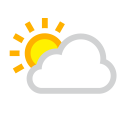Current Weather in Rarotonga
 Partly Cloudy
Partly Cloudy27.2°C81°F
- Current Temperature: 27.2°C81°F
- Current Feels‑Like Temperature: 25.3°C77.5°F
- Current Humidity: 66%
- Minimum Temperature/Maximum Temperature: 23.1°C73.6°F / 23.6°C74.5°F
- Wind Speed: 7.9km/h
- Wind Direction: ↑ From the South
(Data Time 23:00 / Data Retrieved 2025-09-09 23:00)
Climate‑Related Culture in Rarotonga
The cultural and meteorological awareness regarding the climate of the Cook Islands is deeply rooted in the fusion of the oceanic environment and traditional culture, permeating everyday life, tourism, and disaster prevention.
Oceanic Climate and Life Culture
Characteristics of Warm and Rainy Weather
- It is hot and humid throughout the year due to its proximity to the equator.
- Seasonal winds are gently blown by the southeast trade winds, reflecting in wave height and tidal currents in daily life.
Impact on Daily Life
- In fisheries and agriculture, harvesting and planting are timed according to the rainfall during the rainy season (November to April).
- Traditional houses (fare) focus on ventilation and are built with good airflow.
Traditional Weather Prediction and Wisdom
Observing Natural Signs
- Weather changes are sensed through the timing of seabirds' arrivals.
- Predictions of rainfall and wind direction are made based on the color and shape of clouds and the tint of the sea surface.
Inheritance of Oral Knowledge
- The calendar is based on "tide tables" and the "movement of stars" used by elders.
- There are traditions of celebrating and calming weather through astrological elements in festivals.
Meteorological Awareness in Daily Life
Methods of Obtaining Weather Information
- Regularly check weather forecasts through radio and local broadcasts.
- Use smartphone apps and satellite images to prepare for sudden heavy rain or strong winds.
Innovations in Daily Habits
- Avoid outdoor work during times of strong sunlight, shifting tasks to the morning or evening.
- Utilize traditional tools with multiple uses, such as wearing a pareo (cloth) as rain gear.
Disaster Preparation and Disaster Prevention Culture
Response During Cyclone Season
- From November to April, focus on cyclone warnings and prepare evacuation routes and emergency supplies.
- Use community gathering places as shelters and share information at the community level.
Disaster Training and Education
- Conduct annual disaster drills in schools and villages.
- Teach children weather knowledge through meteorological card games.
Response to Tourism and Climate Change
Promotion of Ecotourism
- Incorporate weather explanations into guided tours in nature reserves to promote sustainability.
- Ensure safety management for marine sports based on wind direction and water temperature information.
Awareness of Global Warming
- Coastal erosion and coral bleaching caused by rising sea levels affect tourism resources.
- The entire community promotes reforestation and coral regeneration projects.
Summary
| Element | Example Content |
|---|---|
| Oceanic Climate | Warm and rainy due to trade winds, influence of seasonal winds and tidal currents |
| Traditional Weather Prediction | Observation of seabirds, clouds, stars; tide tables and calendars as oral knowledge |
| Daily Meteorological Awareness | Weather forecast checks through radio and apps, versatile use of traditional tools |
| Disaster Prevention Culture | Focus on cyclone warnings and shelter use, community disaster drills and education programs |
| Climate Change Response | Ecotourism, conservation of tourism resources through reforestation and coral regeneration |
The awareness of climate in the Cook Islands is deeply integrated with a rich oceanic environment and traditional culture, manifesting in a multifaceted manner from daily life to tourism and disaster prevention.